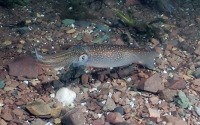
(Photo: Connie Bishop)
Atlantic Longfin Squid
Doryteuthis pealeii
This squid is pink or orange with brown or purple speckles. Its fin is half of its tube-like mantle length. It has eight arms (with suckers all down their length) and two tentacles (with suckers only at the tips). Its mantle can reach up to 50 centimetres long but is usually less than 30 centimetres.
Authority
(Lesueur, 1821)
Classification Details
Phylum: Mollusca (molluscs); Class: Cephalopoda (octopuses and squid).
Habitat
Inhabits the waters of Newfoundland, Bay of Fundy and the Scotian shelf in Canada. Occurs south to Venezuela. Longfins form large schools that make daily vertical migrations. In the daytime they are found near the seabed but migrate up towards the surface at night. They inhabit coastal waters in the summer but migrate offshore to deeper water (100-200 m) during the winter when coastal waters are cold.
Diet
Predator feeding on krill, fish and other squid. Cannibalism is common. When a squid gets close to prey it rapidly stretches its arms and tentacles out to grasp it. This can take as little as 20-30 microseconds. The sharp rings on their tentacle suckers help them latch onto it. They eat prey alive, shredding it with their beak.
Reproduction
Separate sexes. In the spring, when water temperatures are rising schools of squid migrate inshore. They mate during this migration. The male grasps the female with his arms and, using a specially modified arm, transfers packets of sperm to her mantle. The sperm fertilize the female’s egg capsule. Females mate with multiple males and eggs in one capsule can have several fathers. Each gelatinous, finger-like egg capsule contains around 200 eggs. The female uses her arms to attach the sticky end of the egg capsule to rock or seaweed. Females often stick their egg capsule onto those of other females. This makes egg clusters – sometimes known as sea mops. Spawning occurs in August to September in the Bay of Fundy. Females die after spawning. The eggs hatch after 11-27 days into planktonic larvae. The larvae and juveniles resemble adults. This species has a life span of under one year.
Fun Facts
The giant axon nerve fibres in this species are very large – up to 0.7 millimeters in diameter. Much bigger and easier to study than the tiny nerve fibres found in humans. Much of what we know about human nerves comes from studies scientists have made of squid nerve fibres.
This species can change its body pattern using pigment filled chromatophores in its skin. It can expand the chromatophores to make its skin darker or retract them, and reveal underlying light reflecting iridophores, to make its skin lighter. Squid use changes in colour to camouflage themselves and to communicate with each other.
References
Black GAP, Rowell, TW, Dawe EG (1987) Atlas of the biology and distribution of the squids Illex illecebrosus and Loligo pealeii in the Northwest Atlantic. Canadian Special Publication of Fisheries and Aquatic Sciences 100. Hanlon RT (1998) Mating Systems and sexual selection in the squid Loligo: How might commercial fishing on spawning squids affect them? California Cooperative Oceanic Fisheries Investigations Report 39: 92-100. Hanlon RT, Maxwell MR, Shashar N, Loew ER, Boyle K (1999) An ethogram of body patterning behaviours in the biomedically and commercially valuable squid Loligo pealei off Cape Cod, Massachusetts. Biological Bulletin 197:49-62. Jacobson LD (2005) Essential Fish Habitat Source Document: Longfin Inshore Squid, Loligo pealeii, Life History and Habitat Characteristics. NOAA Technical Memorandum NMFS-NE-193. Roper CFE, Sweeney MJ, Nauen CE (1984) FAO Species Catalogue Volume 3. Cephalopods of the world. FAO fisheries synopsis 125 (3). Young JZ (1985). Cephalopods and Neuroscience. Biological Bulletin. 168 (3S): 153-158.

